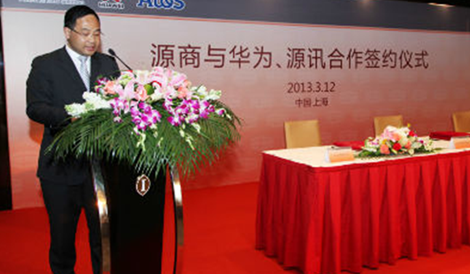Huawei said it will work with Fountain Data Solution, a high availability IT and ISP/IDC service provider in China, to build the Yangpu Cloud Data Center using its own cloud data center solution.
Located at the Zhoujiazui Road, Yangpu District of Shanghai, the Yangpu Cloud Data Center will cover an area of 6,000 sq m, 2,400 sq m of which will be used as whitespace hosting 800 standard cabinets.
Constructed in accordance with Tier III+ standards, the new data center will be equipped with duel grid power supply systems, 2N Uninterruptible Power Supply (UPS) systems and an N+1 cooling system. It will also have fiber connections through multiple telecommunication carriers.
The new data center broke ground in September 2012 and is scheduled to be online in August 2013. It will provide colocation, cloud infrastructure and network resource services to financial, government and high-end enterprise users upon completion.
Huawei said its cloud data center solution will bring flexibility, security as well as energy-saving advantages to the Yangpu Cloud Data Center.
The solution provides elastic resource pooling through virtualization, which enables the customer to use resources based on requirement and reduce IT expenditure.
It also uses energy-saving technologies including in-row cooling to reduce the Power Usage Effectiveness (PUE) rating and operation and maintenance costs.
Huawei said the solution will provide end-to-end security guarantees from infrastructure, network, resource pools, virtual machines to terminal devices to avoid customer data loss and leak.
It will adopt best practices in Information Technology Infrastructure Library (ITIL) for overall management of the data center to enhance business continuity.
Huawei’s modular data center solution
Huawei said it will also deploy its modular data center solution in the Yangpu Cloud Data Center of Fountain Data Solution.
It said this modular approach integrates pre-fabricated racks, power distribution units, cooling systems, monitoring systems, cabling systems and fire protection systems.
It said the solution is designed to bring business online within a short time, achieving high density deployment (9kW/cabinet at maximum) and reduced energy costs.
Prior to project implementation, Huawei used advance Computational Fluid Design (CFD) simulation software to simulate and analyze the air flow of the whole data center to ensure high levels of cooling efficiency.
And it said its modular solution will also utilize advanced cooling technologies to enhance energy efficiency in the data center.
“Our modular data center solution adopts in-row cooling technology and achieves complete separation of cold air and hot air by sealing the cold aisle, which saves about 30% of energy in total compared with traditional data centers,” said Sun Zhenjian, general manager of the Enterprise Data Center Department of IT Product Line of Huawei.
“Each IT module is equipped with one separate redundant air conditioner, which ensures the reliability of the cooling system.”
“Our in-row cooling technology also removes the stringent requirement for data center ceiling height. For traditional data centers using the raised floor cooling technology, the ceiling height requirement is about four meters. Yet with the in-row cooling technology, the ceiling height requirement of our modular data center is only about three meters, which means customers may deploy data centers in commercial residential buildings (about 2.9 to 3 meters in height), making data center construction and renovation much easier.”
Leif Zheng, president of the IT Product Line of Huawei, told Focus that with data growing explosively, energy shortage and environmental protection issues are becoming increasingly salient.
“There are higher and higher requirements for high density and quick [data center] deployment, and intelligent operation and maintenance,” Zheng said.
“Modular data centers enable enterprises to deploy capacity based on requirement and bring their business online quickly, thus reducing energy cost greatly. For medium-sized and small enterprises which are short of capital and land, modular data center is also the best option.”
Huawei’s modular data center solution has been deployed in about ten data centers both domestically and internationally, including South China Base of China Mobile (or International Information Hub of China Mobile), the data center of the largest IT service provider in India NxtGEN and CANTV in Venezuela.
“Take South China Base of China Mobile as an example, it saves two thirds of space thanks to the deployment of our modular data center solution, compared with traditional data centers,” Zheng said.
“Moreover, by taking advantage of in-row cooling and aisle containment technology, coupled with the utilization of Huawei’s ManageOne management platform for overall monitoring of the data center, the data center can achieve a PUE as low as 1.6.”

